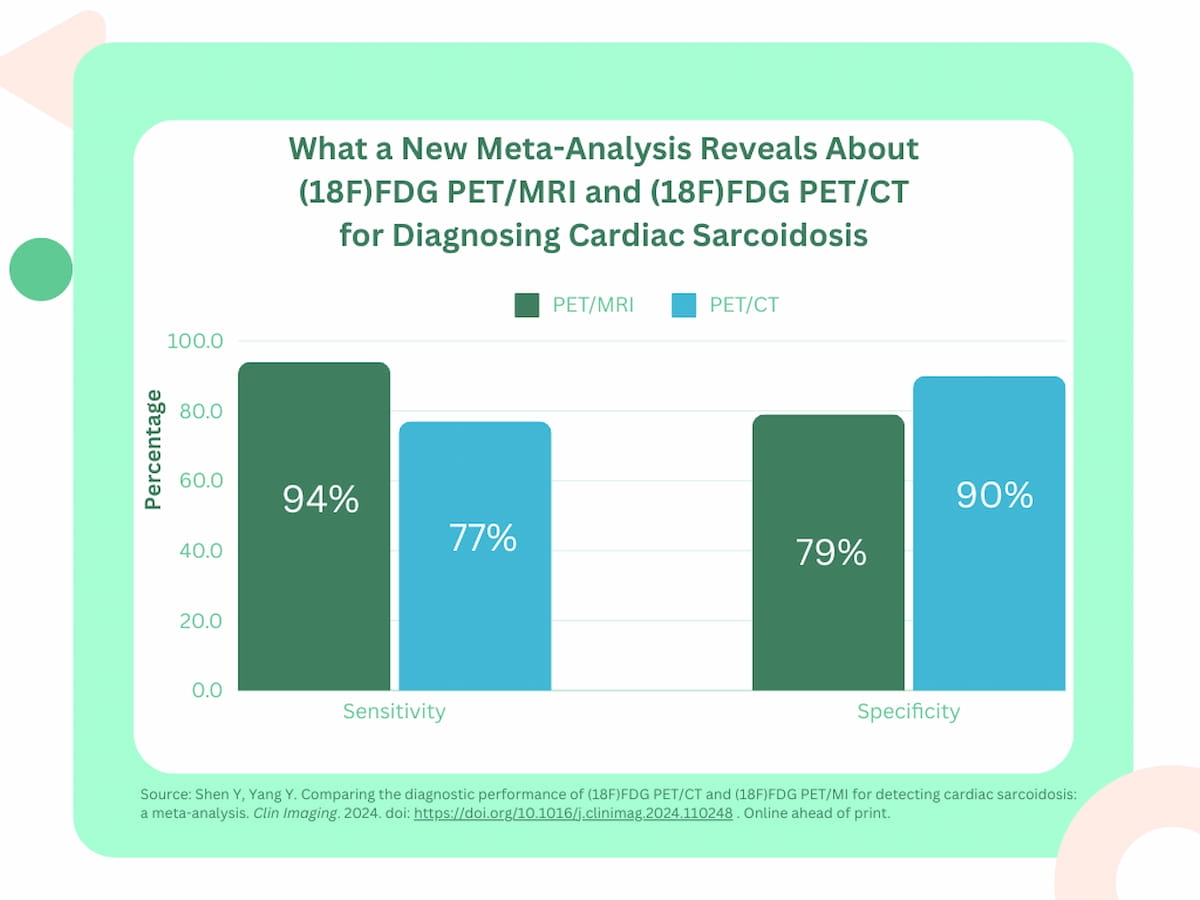For the detection of cardiac sarcoidosis, (18F) FDG positron emission tomography/magnetic resonance imaging (PET/MRI) offers significantly enhanced sensitivity and comparable specificity in comparison to (18F) FDG positron emission tomography/computed tomography (PET/CT), according to a new meta-analysis.
For the meta-analysis review, recently published in Clinical Imaging, the researchers reviewed data from 16 studies and a total of 1,361 patients.
The meta-analysis findings revealed a 94 percent pooled sensitivity rate for (18F) FDG PET/MRI in comparison to 77 percent for (18F) FDG PET/CT. While (18F) FDG PET/CT had a higher pooled specificity rate of 90 percent in contrast to 79 percent for (18F) FDG PET/MRI, there was no statistically significant difference with respect to specificity, according to the meta-analysis authors.
“The superior sensitivity of (18F) FDG PET/MRI compared to (18F) FDG PET/CT in detecting cardiac sarcoidosis may (be) due to MRI’s superior soft tissue contrast and its ability to simultaneously assess metabolic activity and tissue characteristics. This hybrid imaging analysis offers a more complete view of the heart’s functional and structural changes,” wrote the meta-analysis authors Yuanliang Shen, M.D., and Ying Yang, M.D., who are affiliated with the Cardiovascular Department at Huzhou Traditional Chinese Medicine Hospital in Huzhou, China, and colleagues.
However, the researchers cautioned that differences among PET/MRI systems and PET/CT devices, ranging from technical specifications and scanner technologies to imaging protocols, can have an impact on detection capabilities.
Three Key Takeaways
1. Higher sensitivity of PET/MRI. The meta-analysis found that (18F) FDG PET/MRI has a significantly higher sensitivity (94 percent) compared to (18F) FDG PET/CT (77 percent) for detecting cardiac sarcoidosis, likely due to MRI’s superior soft tissue contrast and its ability to assess both metabolic activity and tissue characteristics.
2. Comparable specificity. Although (18F) FDG PET/CT showed a higher pooled specificity (90 percent) compared to (18F) FDG PET/MRI (79 percent), the difference in specificity between the two modalities was not statistically significant.
3. Impact of technical variations. The detection capabilities of PET/MRI and PET/CT can be influenced by differences in technical specifications and scanner technologies. The number of CT slices in PET/CT studies varied, which could impact performance, but such details were not available in eight of the 12 reviewed PET/CT studies, limiting a comprehensive assessment.
For example, while only four of the reviewed 12 PET/CT studies noted details on CT slices, the researchers noted variation with six-slice CT, 16-slice CT and 64-slice CT being utilized.
“These (differences) in the number of slices could potentially influence the performance of PET/CT. However, such technical details are relatively scarce in most studies, preventing us from assessing their impact on PET/CT through appropriate statistical methods,” pointed out Shen and Yang.
While PET/MRI may provide improved sensitivity for cardiac sarcoidosis, the meta-analysis authors noted that PET/CT is less expensive and offers greater availability. They suggested that future research should examine the cost-effectiveness of the modalities for diagnosing cardiac sarcoidosis.
(Editor’s note: For related content, see “FDA Clears CT-Based Tools for PE Detection and Stroke Severity Assessment,” “New Literature Review Assesses Merits of Cardiac MRI After Survival of Sudden Cardiac Arrest” and “Image IQ Quiz: 55-Year-Old Woman with Progressive Joint Pain, Fatigue and Weight Loss.”)
In regard to study limitations, the authors acknowledged the lack of comparative studies and a smaller sample size for assessment of (18F)FDG PET/MRI. The researchers also noted the majority of reviewed studies were retrospective.
